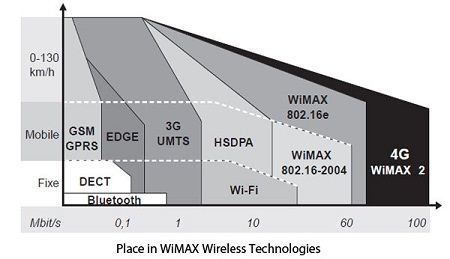WiMAX (Worldwide Interoperability for Microwave Access) is the result of an initiative launched in 2001 by the WiMAX Alliance. Its aim was to promote the IEEE 802.16 standard by proposing to verify compliance and equipment interoperability. As we shall see, many options have been proposed to achieve communication.
WiMAX comes in two versions, a fixed version, which was finalized under the WiMAX IEEE 802.16-2004 name and the mobile version IEEE 802.16e-2005.
Using WiMAX is very similar to that of an ADSL modem, except that instead of a telephone cable is used the airwaves. That is why we speak of WSDL (Wireless DSL) to describe the WiMAX solution. As regards the mobile version, its use is identical to that of a mobile ADSL. The obvious advantage is that mobile WiMAX still has on oneself. With equipment with a WiMAX connection, it is possible to connect from anywhere, anytime, including while on the move.
Figure shows the position in the WiMAX wireless network environment.

Within the 802.16 group, two sub-groups dealing with communications in frequencies located, for the first, between 1 and 11 GHz, and the second between 10 and 66 GHz. In Europe, standardization of the same domain is done by ETSI (European Telecommunications Standards Institute), where the working group BRAN (Broadband Radio Access Networks) offers Hiper access standard (High-Performance Radio Access) or HiperLAN 3 as a solution to access high-speed broadband networks. This proposal allows for IP or ATM networks offering speeds of around 25 Mbit/s.
The 802.16 working group has set up sub-groups, which have tackled different problems. The basic working group has standardized a metropolitan access in the 10-66 GHz band with a direct view between the antennas and point to point protocol. Finalized in 2001, the IEEE 802.16 standard has been supplemented by 802.16c standard 2002, which introduces WiMAX system profiles, and a portion of the 802.16d standard of 2004, which provides fixes and additional features allowing compatibility 802.16e standard.
Released in 2003, the 802.16a standard concerns the band of 2 to 11 GHz, with the option to use multicast protocols in addition to the base point-to-point environment. The standard 802.16ea intended to extend to mobile WiMAX terminal machines, involving the possibility of xDSL connections to mobile. The frequencies used are between 2 and 6 GHz.
The litters are announced 50 km at a rate of 70 Mbit / s, but these values are only theoretical, since they require very high power with high directivity and a direct view. In fact, the maximum distance is about ten kilometers and, according to the power, directivity and direct view, the flow rates are between 40 and 50 Mbit/s. More typically, by sharing the line and being under standard conditions with 90 ° antennas, the maximum throughput is more of the order of 30 Mbit / s. This suggests that the number of ADSL customers can benefit from a rate of the order of megabits per second can reach into the hundreds line.
To increase the flow rates must be reduced by reducing the scope, for example, the power. Flow rates of fifty megabits per second are possible in this case. To use WiMAX in the city and benefit from a large number of customers, the cell size should not exceed about 1 km.
 Dinesh Thakur holds an B.C.A, MCDBA, MCSD certifications. Dinesh authors the hugely popular
Dinesh Thakur holds an B.C.A, MCDBA, MCSD certifications. Dinesh authors the hugely popular